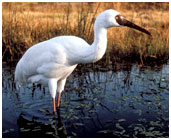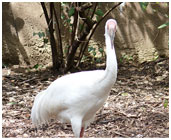The Siberian Crane is a beautiful bird that is under the threat of extinction. Check out interesting facts and amazing information about the Siberian Crane.
Facts About Siberian Crane
The Siberian Crane is one of the most beautiful birds found in the world. It has a milky white body and feathers and a bright brick red coloring on the face. The habitat of the Siberian Crane is the most specialized of all the cranes. It looks out for wide expanses of shallow fresh water in order to make a nest and breed. Siberian Cranes have a shrill flute like voice and the males dance while wanting to attract females to mate. To know more interesting facts and amazing information about the Siberian Crane, read on.

Facts About Siberian Crane
Kingdom: Animalia
Phylum: Chordata
Class: Aves
Order: Gruiformes
Family: Gruidae
Species: G. leucogeranus
Genus: Grus
Length: 120 - 140 cm
Weight: 8 - 10 kg
Diet: Plants, Roots, Seeds, Berries, Insects, Small Mammals, Fish and Frogs
Natural Habitat: Wetlands with widespread areas of shallow fresh water with good visibility
Number of Eggs: 2
Interesting and Amazing Information on Siberian Crane
- Siberian Cranes are native to arctic Russia and western Siberia.
- In Siberian Cranes, males and females are literally indistinguishable. Males just tend to be slightly larger in size and females tend to have shorter beaks than males.
- Siberian cranes lay eggs between May and mid-June. Usually, two eggs are laid but just one chick is reared successfully.
- Every winter, Siberian Cranes migrate from Russia to warmer climes. In India Bharatpur Bird Sanctuary is their seasonal home.
- The specie has become endangered due to the fact that it is hunted on its migratory route, which is located in Iran and Afghanistan and also due to destruction of wetlands.
- Siberian cranes are basically omnivorous and eat berries, plants, roots, seeds, insects, etc. However, outside their breeding season, the eating pattern is predominantly vegetarian.
- In order to reach their wintering grounds in India, Siberian cranes cross over the mighty ranges of the Himalayas at the staggering cruising altitude that is meant for jetliners!
- This species is the most threatened of the fifteen cranes species in the world.
- These birds are not born with a white plumage; they attain it as they grow up. The young birds have a black plumage till they develop into adults.
- Similarly, these young cranes are born with beautiful blue eyes but they turn into pale yellow when they become adults.
- These fowls begin mating from May and the season lasts until June. They produce certain sounds and make particular body movements in order to lure their partners.
- The Siberian crane is the most aquatic of all the crane species, thriving in the wetlands for breeding, feeding and nestling. In terms of behavior these cranes have a distinctive behavior, not found in other crane species.
- Siberian cranes build their nests in marshlands or swamps, where the water is fresh and clean. The two eggs which a female crane lays are incubated for approximately 29 days, both by the male and the female. It takes 70-80 days for the chicks to take their first flight.
- These birds are highly territorial when it comes to their breeding areas.
- Their vocalizations are loud and musical (flute-like).
- The present population is estimated to be around 3,500-4,000individuals.
- During their non-breeding seasons, the Siberian Cranes settle in large and remote wetlands.
- In the winters they are found in the ridges and mudflats of seasonal lakes of the Yangtze Basin (China), open jheels, or grasslands near water. The ones in Indian and Iran habitat in the artificial water bodies and waterlogged rice fields.
- For the natives of Siberia, the white crane is considered a sacred bird. It is associated with sun, spring and the kind celestial spirits called ajyy.
- The Siberian Crane was illustrated by Ustad Mansur, a 17th century court artist and singer for Jehangir, 100 years before Peter Pallas described it officially in 1773.


See also
More from iloveindia.com
- Home Remedies | Ayurveda | Vastu | Yoga | Feng Shui | Tattoos | Fitness | Garden | Nutrition | Parenting | Bikes | Cars | Baby Care | Indian Weddings | Festivals | Party ideas | Horoscope 2015 | Pets | Finance | Figures of Speech | Hotels in India : Delhi | Hyderabad | Chennai | Mumbai | Kolkata | Bangalore | Ahmedabad | Jaipur
- Contact Us Careers Disclaimer Privacy Policy Advertise With Us Lifestyle Sitemap Copyright iloveindia.com. All Rights Reserved.



